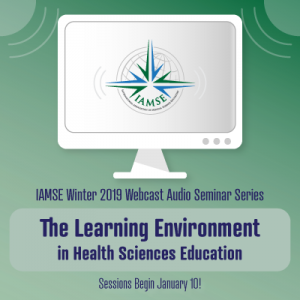
[The following notes were generated by Will Brooks, PhD]
IAMSE Webinar Series, Winter 2019
Speakers: Luke Mortensen – Professor and Chair, Pharmacology, Physiology & Pathology, Idaho College of Osteopathic Medicine
Cindy Anderson – Associate Dean for Academic Affairs and Educational Innovation, The Ohio State University
Karen Hills – Chief, Educational Development, Physician Assistant Education Association (PAEA)
Title: The Learning Environment Panel Discussion
Series: The Learning Environment in Health Sciences Education
Osteopathic Medical School Learning Environment
- 35 accredited osteopathic medical schools, 30,000 students
- Greatly increased focus on well-being and mental health amongst learners in recent years
- DO students have spear-headed many national initiatives on mental health and self-care including the Mental Health Awareness Task Force, a part of the AACOM
- DO student leadership group developed a set of videos on wellness to promote the topic, which have gained much attention
- Empathy tends to erode as learners progress through training, but this decline has not been observed in osteopathic medical education
Nursing Education Learning Environment
- National Academy of Medicine has called to action a focus on burnout for all healthcare providers including nursing
- Burnout affects nurses and has negative effects on the clinician and on patient outcomes
- Impaired physical and mental health increase the odds of making medical errors among nurses
- The Ohio State has developed a Nurse Athlete program to promote wellness among graduates as they transition into the workforce. Participants exhibited fewer symptoms of depression and better overall health. This could be a strategy to promote health and wellness from the early stages of career.
- The College of Nursing utilizes a LIVE WELL curricular model, which is embedded into its programs: Lead, Innovate, Vision, Execute, Wellness-focused, Evidence-based, Lifelong learners, Lights for the world.
- To establish a culture of wellness, The Ohio State has utilized a variety of strategies including a wellness onboarding program for all health sciences students
- Health coaching at least once a week resulted in healthier lifestyle behaviors for both coaches and those being coached
Physician Assistant Education Learning Environment
- 238 ARC-PA Accredited PA programs
- Learning environments include classrooms, simulations, clinical settings, and longitudinal rotation settings
- PA learners participate in interprofessional educational activities in addition to traditional didactics and case/team/problem-based activities
- Mistreatment and unprofessional behaviors occur in PA education as they do in other health professions programs
- Strategies to reduce these behaviors include role playing difficult scenarios, stress management and self-care in orientation, professional coaching, preceptor orientation and communication, and faculty development
- PAEA provides a variety of faculty development activities for PA faculty in areas of wellness
ARC-PA accreditation standards include wellness of faculty and staff